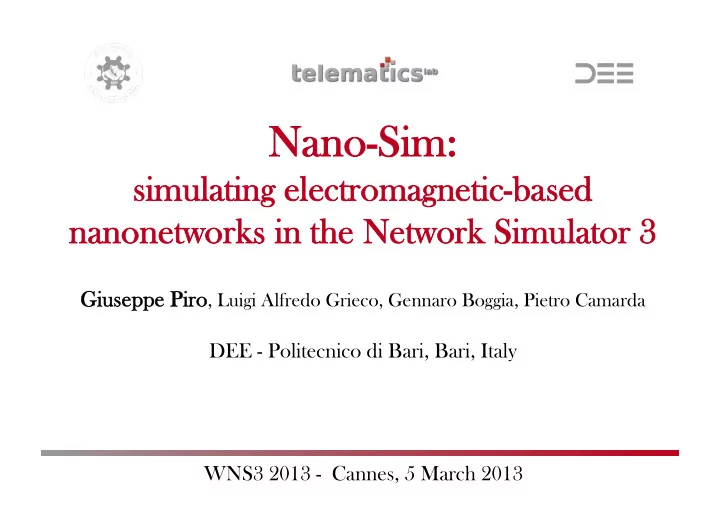

Nano-S -Sim: si simul mulat ating ng elect ctromagnetic-b c-based nanonetworks nanonet works i in t the N Network S Simulator 3 Giuseppe P Piro , Luigi Alfredo Grieco, Gennaro Boggia, Pietro Camarda DEE - Politecnico di Bari, Bari, Italy WNS3 2013 - Cannes, 5 March 2013
Outline - Introduction on Wireless Nano Sensor Networks - what is a WNSN ? - Research activities on WNSN - what has been aready done in literature ? - why we need for a WNSN network simulator ? - NANO-SIM: our proposal - main features - performance evaluation of WNSNs in a health-care application - Conclusions and future works
Introduction on WNSN A Wireless Nano Sensor Network is composed by integrated machines (at the nano scale), which interact on cooperative basis through EM communications. WNSN is not a WSN Devices size ranging from one to few • hundred of nanometers; Graphene-based nanoantennas • supporting EM communications in the THz band; Bit rates extremely higher (terabit/ • s); Very little transmission ranges (tens • of millimeters) • It is impossible to transmit signals with long duration;
Research activities on WNSN Consolidated activities: characterization of the channel at the nano scale Ongoing activities: design of the protocol stack, including channel access procedures and routing strategies What do we need ? a flexible simulation tool
NANO-SIM NANO-SIM is open-source tool for simulating WNSN, implemented within the NS-3 simulator
NANO-SIM – main features At the present stage, it implements:
NANO-SIM – main features At the present stage, it implements: different kinds of devices forming a WNSN o Nanonode : tiny device; scarce energy, computational, and storage capabilities; diffused into a target area for sensing the environment; o Nanorouter: aggregate and process the information coming from nanonodes; o Nanointerface: inter-networks the WNSN with the rest of the world.
NANO-SIM – main features At the present stage, it implements: different kinds of devices forming a WNSN; message processing unit o CBR application
NANO-SIM – main features At the present stage, it implements: different kinds of devices forming a WNSN; message processing unit; routing module o it handles both selective flooding and random strategies
NANO-SIM – main features At the present stage, it implements: different kinds of devices forming a WNSN; message processing unit; routing module; two different Media Access Control protocols o Transparent-MAC : the packet is directly delivered to the PHY interface o Smart-MAC : a handshake procedure is used for discovering nanomachines within transmission range; the packet is delivered when at least one node has been found
NANO-SIM – main features At the present stage, it implements: different kinds of devices forming a WNSN; message processing unit; routing module; two different Media Access Control protocols; a physical interface based on the Time Spread On-Off Keying (TS-OOK) modulation
NANO-SIM – main features At the present stage, it implements: different kinds of devices forming a WNSN; message processing unit; routing module; two different Media Access Control protocols; PHY and channel entities have been implemented by extending the Spectrum Framework o at this moment, the transmission is based on the knowledge of the transmission range
NANO-SIM – device’s structure
NANO-SIM – Performance Evaluation We studied an health-monitoring system based on WNSN artery hosting nanonodes and nanorouters nanointerface
NANO-SIM – Performance Evaluation PLR – Transparent-MAC and Selective Flooding The PLR decreases as the density of nanonodes and their transmission range increase because there are more chances to find a multi-hop path to the nanorouter/nanointerface.
NANO-SIM – Performance Evaluation PLR – Smart-MAC and Random Routing The random routing algorithm leads to a slight increase of the PLR: the random selection of the next hop may prevent to some packets to reach the destination before the expiration of the TTL.
NANO-SIM – Performance Evaluation Number of PHY Transmissions – Transparent-MAC and Selective Flooding PHY transmissions increase with the density of nanonodes and the transmission range
NANO-SIM – Performance Evaluation # PHY Transmissions – Smart-MAC and Random Routing The random routing strategy is able to decrease the number of PHY transmissions
Conclusions and future works We developed an open source tool modeling WNSNs within the NS-3 simulator. We believe that, thanks to its extremely modularity, NANO-SIM has all the characteristics to become a reference tool for researchers working in the area of nano-networks. As next steps of our work, we plan to extend the simulator by implementing new features, i.e., better routing and MAC protocols and more sophisticated PHY and channel models.
Many t y thanks f for yo your a attention! Giuseppe P Piro , PhD. Post Doc Researcher at DEE, Politecnico di Bari via Orabona 4 - 70125 (Bari), Italy. phone: +39 080 5963301 email: g.piro@poliba.it web: telematics.poliba.it/piro
Recommend
More recommend